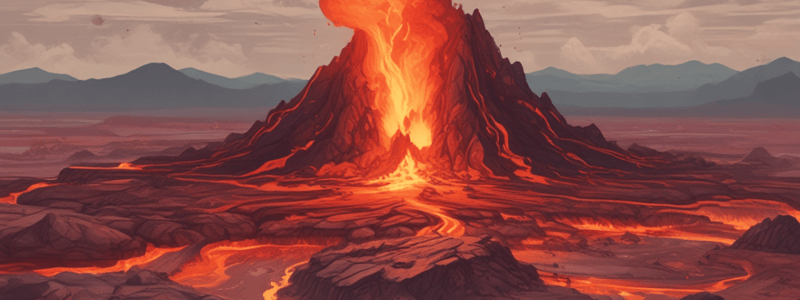Podcast
Questions and Answers
What is the primary source of heat that contributes to the formation of magma?
What is the primary source of heat that contributes to the formation of magma?
- Heat leftover from Earth's violent past and the decay of radioactive elements (correct)
- Heat from the Earth's core
- Heat generated by tectonic plate movement
- Heat radiating from the Sun
What happens when magma reaches the surface of the Earth?
What happens when magma reaches the surface of the Earth?
- It evaporates into the atmosphere
- It is referred to as lava (correct)
- It solidifies into solid rock
- It forms a new crust on the surface
What is a characteristic of magma that causes it to rise from within the Earth?
What is a characteristic of magma that causes it to rise from within the Earth?
- It is highly reactive
- It is less dense than the surrounding solid rock (correct)
- It is denser than the surrounding solid rock
- It is highly viscous
What can vary in magma composition?
What can vary in magma composition?
What can be present in magma besides molten rock?
What can be present in magma besides molten rock?
What is the characteristic of magma in terms of its composition?
What is the characteristic of magma in terms of its composition?
What is the primary location of magma within Earth?
What is the primary location of magma within Earth?
What is the temperature range of magma beneath the Earth's surface?
What is the temperature range of magma beneath the Earth's surface?
What is the primary mechanism for magma formation in the upper mantle?
What is the primary mechanism for magma formation in the upper mantle?
What is the result of the subduction of plate material in terms of magma formation?
What is the result of the subduction of plate material in terms of magma formation?
What is the primary reason for the formation of magma at subduction zones?
What is the primary reason for the formation of magma at subduction zones?
What is the role of water in the formation of magma at subduction zones?
What is the role of water in the formation of magma at subduction zones?
What is the characteristic of felsic magma in terms of its composition and temperature?
What is the characteristic of felsic magma in terms of its composition and temperature?
What is the main difference between magma and lava?
What is the main difference between magma and lava?
What is the type of igneous rock that forms when magma solidifies while inside Earth's crust?
What is the type of igneous rock that forms when magma solidifies while inside Earth's crust?
Flashcards are hidden until you start studying
Study Notes
What is Magma?
- Magma is liquid rock found beneath Earth's surface, formed when rocks melt.
- It is less dense than solid rock, so it rises to the surface, where it's referred to as lava.
- Magma forms within the interior of Earth, mainly in the crust and upper mantle, due to heat and radioactive decay.
- It can vary in composition, containing dissolved gases like carbon dioxide and hydrogen sulfide.
Formation of Magma
- Magma forms through decompression of rising heat and material from mantle plumes or convection currents.
- Subduction of plate material colliding with another also creates the circumstances for solid rock to melt.
- Mantle plumes rise over long geological timeframes, eventually reaching the base of the lithosphere, where they spread out and melt.
- Decrease in pressure as mantle plume and convection current material rises allows for particles to spread out, melt, and form magma.
Characteristics of Magma
- Temperature range: 1060-1600°C (besides rare carbonatite magmas at 490°C).
- Viscosity and resistance to flow vary depending on the type of magma.
- Some magmas are more viscous, while others flow quickly.
Types of Magma
- Felsic magma: high silica content (>63%), low iron content, highly viscous, and relatively low temperature (800-1200°C).
- Mafic magma: lower silica content (<45%), higher iron content, less viscous, and higher temperature (1100-1600°C).
- Ultramafic magma: very low silica content, high iron content, and high temperature.
Difference between Magma and Lava
- Magma is liquid rock beneath Earth's surface.
- Lava is magma that has reached Earth's surface, where it cools and solidifies into rock.
- Igneous rocks form from the solidification of lava or magma.
Studying That Suits You
Use AI to generate personalized quizzes and flashcards to suit your learning preferences.




